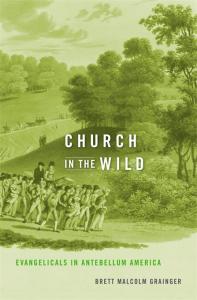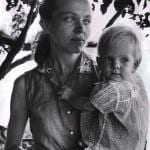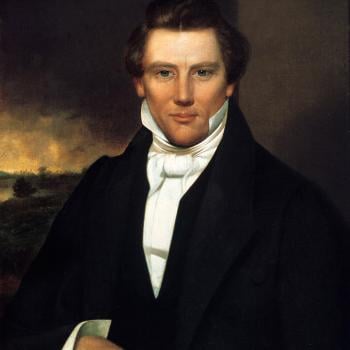As a teenager, I twice went to Young Life‘s Saranac Lake summer camp. These were amazing weeks. Worship, fun and games, and talks by hip young speakers. The ostensible reason for the camp was evangelism. The talks culminated in an invitation for people to confess their sins to God and invite Jesus Christ into their lives as Lord and Savior. If we were already Christians, we should more fully devote ourselves to Christ. On the final night each year, the speaker instructed campers to go out into the woods, find a secluded spot, and talk with God.
Why the woods? The point was to be alone, surrounded by nature and by God. Had we gone back into our cabins, we would not have been praying in solitude. But nature might also sharpen the campers’ encounter with God. Perhaps it was easier to grasp one’s sinfulness in isolation. Perhaps the rustle of the wind helped one feel God’s Spirit.
 In his recently published Church in the Wild, Brett Malcolm Grainger suggests that what I experienced at Young Life camp harkens back to earlier time periods. “The most significant school of nature mysticism in nineteenth-century America,” Grainger writers, “was not that elite and regional club known as Transcendentalism but evangelical revivalism.”
In his recently published Church in the Wild, Brett Malcolm Grainger suggests that what I experienced at Young Life camp harkens back to earlier time periods. “The most significant school of nature mysticism in nineteenth-century America,” Grainger writers, “was not that elite and regional club known as Transcendentalism but evangelical revivalism.”
This is a wide-ranging and creative book, partly because Grainger has spent so much time with the hymnals, poems, diaries, and other writings of antebellum evangelicals. When evangelicals looked at the world around them, they saw God, they saw Christ. “In growing fields of corn, the lily and the thorn,” penned Jeremiah Infalls in the shape-note hymn “Honor to the Hills,” “The pleasant and forlorn, All declare God is there; In meadows drest in green, There’s he’s seen.” As far as most American Protestants were concerned, Nature’s God was the same as the Bible’s God. And whereas deists saw a university “ruled by distant architect,” and whereas Transcendentalists saw the divine in nature and understood themselves as connected to it, evangelicals saw a garden tended by their Lord. When they went into the woods to pray, they often met the gardener.
Evangelicals more typically went into the woods en masse. They gathered at the banks of a river to watch baptisms. They gathered in camp meetings. They also sacralized the landscape in ways that would have been anathema to seventeenth-century puritans, who were far more vigilant against anything that smacked of idolatry. They named towns after biblical sites such as Goshen, they made pilgrimages to the camp meetings and groves at which they had experienced conversion. Rocks and riverbanks became holy places. As Grainger observes, evangelicals had biblical precedents — Jacob pouring oil over a rock at the place he named Bethel — for such actions.
Grainger has an eye for detail. He notes that although camp meetings typically took place in the summer and autumn, those who believed in believer’s baptism baptized at any time of the year, and in nearly all circumstances these were outdoor baptisms. Since God commanded new believers to be baptized, those believers could not wait for fair weather. Winter baptisms were hazardous affairs, though, as “helpers cut through ice often more than a foot thick, carving a rectangular hole the size of a grave.” A few unlucky converts imitated Christ’s death a bit too much. Even so, some Baptist hymns urged converts to buck up. “Children prove your love to him,” encouraged one hymn. “Never fear the frozen stream.” It’s enough to confirm me in the paedobaptism of my church.
The cast of characters in The Church in the Wild is also remarkable. In later chapters which discuss evangelical fascination with everything from hydrotherapy to electrical therapy (John Wesley was a proponent) to animal magnetism, readers meet figures such as Edward Hitchcock, a minister and geologist who embraced mesmerism but then watched as some of its adherents abandoned orthodox Christianity for spiritualism. Grainger also makes some brief but arresting comparisons between the nature mysticism of white evangelicals and that of African American evangelicals.
Grainger explains that evangelicals eventually backed away from the nature mysticism that was in many ways central to their spiritual practices in the first half of the nineteenth century. Many moved to cities. Upwardly mobile Methodists and Baptists built sturdy and stately churches. Camp meetings became less central to evangelical revivalism. Baptists built baptisteries (a good idea in the winter, at least). Evangelicals stopped reading devotional manuals such as Richard Baxter’s Saints’ Everlasting Rest. Also, evangelicals lost faith that Nature and the pointed to the same God. “While liberal Protestants continued to affirm God’s twofold revelation through the Word and the world,” Grainger writers, “fundamentalists doubled down on the total sufficiency of scripture in ways that seemed to demote the book of nature to secondary status.”
Glimmers remained of earlier periods of nature mysticism. Think of Billy Graham reaffirming his faith in the Bible at the Forest Home retreat center near San Bernardino, California (a rock with a plaque marks the spot, not that different from the sacralization of the landscape a century earlier). And retreats, summer camps, and other moves into the wilderness continued to play key roles in evangelical spirituality. Still, there’s a reason why nature mysticism in contemporary America is associated with “spiritual not religious” rather than evangelicalism.
Grainger contends that for evangelicals, “contemplation and its social benefits took a back seat to mere evangelism: Jesus was coming back, and there was no time to smell the roses.” Evangelicals abandoned the “broadly ambitious life of sanctification” for “the narrowly conceived work of soul winning.” I don’t think that’s quite right. Grainger himself allows that Holiness and Pentecostal movements preserved an emphasis on sanctification, without as much need for the book of nature. But it wasn’t just evangelical offshoots. From the Keswick Movement to the early YMCA to groups such as the Navigators, discipleship, sanctification, and evangelism went hand in hand, even if adherents spent less time among the roses.
Still, Grainger gives contemporary evangelicals — really, any contemporary Christians — a valuable glimpse of older forms of nature mysticism. “For those with the eyes to see,” he explains, “Christ could be seen, felt, tasted, and even worshipped in the visible creation.” A walk in the woods wasn’t enough, moreover. That taste of Christ depended on patterns of piety, devotional manuals, communal worship, as well as sacred rocks and tree stumps. Pretty wild stuff.













